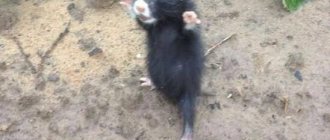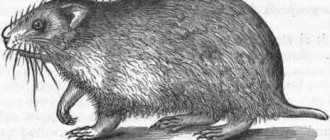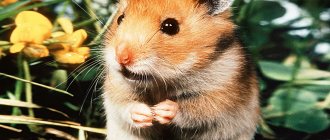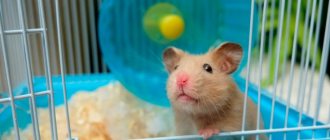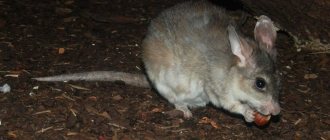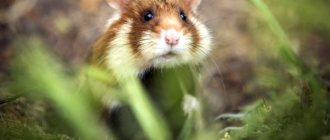The closest relatives of domestic rodents have noticeable differences in lifestyle and physical development, since life in the wild requires skill and independence. The steppe hamster has a large body size, small ears, and well-developed limbs. Wild rodents have especially developed fingers, which serve them to create a home - digging large holes in the ground.
Steppe rodents are absolutely unique and do not need human help in order to survive. On the contrary, such hamsters can show aggression in response to attention from people, so when meeting a steppe inhabitant, do not try to communicate or obsessively feed the animal.
Lifestyle
Hamsters are nocturnal animals, and therefore their activity time is late at night, sometimes early in the morning.
During the day, these animals sit in burrows and will leave their shelter only in case of imminent danger. They lead a solitary lifestyle and, despite their small size, zealously defend their territory from the encroachments of other rodents. Males are friendly to females only during the mating period. The rest of the time they do not show attention, but they can also be aggressive when it comes to survival or the fight for food.
Information in the encyclopedia talks about the increased aggressiveness of animals. They can attack a person for no reason simply from a hole. Such situations especially occur in the fall, when the animal is preparing supplies for the winter. Hamsters' teeth are small and very sharp, and therefore the bites leave deep, with severe pain. The wound may be infectious, so urgent disinfection or hospitalization is required.
Steppe hamsters often attack other animals. The size, weight and appearance of the enemy are not important; the speed and sharp teeth of this rodent can put even a fox or wolf to flight.
Sex identification in hamsters
Finding out the gender of your rodent is easier than you probably thought. The main way to determine the sex of your hamster is by looking at its tail. You need to observe the rodent's perianal area, which is just below its tail, and apply slight pressure to separate the hair from the skin.
In males this area is more pronounced than in females due to the presence of her testes. In addition, the distance between the anus and the penis is greater in the male hamster.
You can also check the umbilical gland to determine the gender of your hamsters. In male hamsters, a small “belly button” can be seen in the umbilical area, which is more noticeable than in females.
However, ideally you should wait until your hamster reaches sexual maturity to properly determine its sex. In general, these small rodents mature and become sexually active very quickly: approximately 30-50 days after birth.
After puberty, the hamster is ready to mate and reproduce. Therefore, it is very important to know about the reproductive cycle of a hamster. If you want to avoid unwanted litters, we recommend keeping your males and females in separate cages.
Harm to people
There are many ways to fight a hamster
Aggression is not the only drawback of wild animals. Most of them live on human lands: vegetable gardens, fields, orchards. They quickly destroy plantings and finished products. The main task of man is to protect his territories.
One hamster won't do much damage. But they multiply quickly, so action must be taken quickly.
Fighting methods
Rat poison will not help in the fight against steppe rodents. After eating it, the animals’ well-being does not deteriorate.
Effective methods of combating wild hamsters:
- Trap. Place a treat inside. The device can be purchased or made independently. There are several varieties. Some traps kill, others only close. Interesting advice from summer residents - be sure to tie the instrument to something.
- Flooding of holes. You will need a lot of water - 2-3 buckets, depending on the depth of the hole. Close all entrances and exits. Leave only the one into which water will be poured. The hamster will try to escape through it. Do this during the day while the animal is in the house.
- Other animals. The cat will catch a small wild hamster. A dog can handle a large animal.
- Poisoned baits. An important fact is that the dose must be large. The hamster will not react to small ones. Try different types of poison. Steppe rodents are resistant to poison in small quantities.
The least effective remedy is bright light. Regularly flash a bright stream of light into your hamster's hole. Be prepared for aggression and possible bites.
Dealing with a wild animal is difficult. This may take a whole month. To speed up the process, try different ways of fighting.
Steppe hamsters are dangerous animals. Capable of scratching a person's hand. Their bite can cause an infectious disease. They do not accept care and have an aggressive character.
Externally they are distinguished by large ears and a long body. You can remove rodents from your garden. To do this, use one of the methods of struggle.
Description of the species
The common steppe, or field, hamster is nocturnal and is the largest representative of this family. He spends his days mostly in the hole, and at night he goes out to fish.
These animals are solitary animals and live in pairs only during the breeding season. They are pugnacious, can show aggression towards each other, and are not afraid to attack an opponent much larger than themselves, even a person. Before the attack, the fluffy stands on its hind legs and attacks with a swift jump. Their natural enemies are predators such as ferrets and foxes.
We recommend reading what breed of hamster to choose and how to care for a Syrian and Djungarian hamster
In the description, the common hamster appears to us as a cute, fluffy animal with a brightly colored skin. It has thick soft fur of a red or grayish-brown color; the belly and the area between the ears are black; The cheeks, cheek pouches, and tips of the paws are white, and white stripes also decorate the sides. Paws with well-developed toes and sharp claws on the inside are pink. The tail is up to 8 cm, covered with short, stiff hair. Body length up to 34 cm, weight up to 800 grams.
Those who want to have such a pet are interested in the question: do hamsters hibernate? In nature, they spend the winter in burrows, but they do not sleep soundly: they wake up about once a week to eat and relieve their natural needs.
Also, at home you can keep such rodents as: jerboa, Chilean squirrel, chipmunk, squirrel, capybara, guinea pig, dormouse
General characteristics of the field rodent
Field hamsters are large breeds of rodents. In nature, there are smaller (20 cm in length) and larger (34–40 cm) adult specimens.
The weight of an average animal is 650–750 grams, but with good nutrition they can weigh up to a kilogram.
What does a hamster look like? The animal's tail is powerful, 3–10 cm long, wide at the base, tapering towards the tip.
The mustache is remarkable: hard, like metal wire.
The ears are rounded, small, and the muzzle is not very elongated. The beautiful pouches on the sides where the hamster stores supplies are a constant subject for cartoonists. But they play the role of more than just storerooms. If a rodent needs to swim across a river, it fills them with air and these “balloons” allow it to float on the water.
The paws are wide, strong, with tenacious elastic fingers that have dangerous sharp claws. This is an excellent karbysh tool for digging underground tunnels.
The animal has soft, thick, beautiful fur. The undercoat protects from the cold. The color of the field hamster is bright. It can be different: red, black with spots, brown.
Often on the sides in the area of the front legs, behind the ears or behind the shoulder blades, the hamster has two light spots. The hamster of the steppe zone with such markings is very beautiful.
Mink
Being prey to larger predators, the animal prefers to live in burrows that it digs itself, although sometimes it can occupy the abandoned home of a gopher. A hole is a complex structure of many tunnels, the total length of which can be eight meters and up to two and a half in depth. For safety, the rodent makes up to a dozen entries and exits.
We advise you to find out useful information about hamsters, namely: what hamsters eat, how many years they live at home and how to set up a cage for a rodent.
The housing system provides places for storing food, several of them, a latrine and a resting place, covered with a soft bedding of herbs and wool. At the end of summer, the animal begins to actively stock up on food supplies.
During the active summer time, the wild hamster happily feeds on small vertebrates, insects and their larvae, and in the winter it sneaks grain crops into storerooms so that it has something to eat without going to the surface. Among the winter reserves of the dug holes, up to 90 kg of potatoes and various grains were found: buckwheat, millet, wheat, corn, peas, etc.
The rodent's cheek pouches allow it to carry about 46 grams of grain at a time, so throughout August and autumn, before the onset of frost, the voracious baby scurries from field to pantry.
Did you know? Hamsters can swim. These funny rodents, taking air from their cheeks, boldly rush into the water, using their cheek pouches as rescue pillows that support their heads above the water.
Keeping at home
A wild hamster looks like a plush toy, but it is unlikely to be tamed, so remember that it is quite capable of clawing at the hand that feeds it. If you decide to have such a pet, provide him with personal space where he can set up a home close to natural conditions.
Behavior and lifestyle
Since the animal is not small in size, it needs a spacious home in which it can arrange a sleeping place, a storage room and a toilet. He will need a place where he can hide from prying eyes: for example, an overturned pot or a cardboard box. Place scraps of fabric, cardboard, paper for him, cover the bottom of the cage with sawdust - he will do the rest himself. The steppe hamster tends to overeat, so you need to prepare a running wheel for it.
Important! Be sure to put a mineral stone in the cage: the animal will grind its teeth on it. The fact is that his teeth grow throughout his life - if they are not ground down, they will begin to interfere with the rodent and can even cause his death.
Since it is impossible to tame a field hamster, do not bother him by trying to pick him up, cuddle him, or stroke him - he does not like this. As already mentioned, during the day the animals usually spend time in the nest, but at home they can get out and walk around their territory.
The common field hamster can eat almost anything: vegetables, fruits, grains, bread, boiled meat and even lard (in small quantities). It is recommended for your pet to add vitamins A, D, E, and fish oil to the food: if these are oil-based vitamin preparations, it is enough to add one drop to the food once a week. Plant foods should still predominate in the diet: cabbage, carrots, apples, sunflower seeds, wheat grains, oats and other vegetables and fruits.
Did you know? Forest hamsters of North America, like magpies, drag into the house everything that glitters, often carelessly left by humans household items or decorations.
Breeding
The mating period in rodents lasts from April to August; a female can have up to three litters per year, numbering from four to twelve individuals. Please note that it is not advisable for the male to remain on the female’s territory for a long time after mating; she may bite him to death. In order for mating to be successful and without incidents, there are several rules:
- Partners must not be from the same litter.
- The female needs to be younger than the male.
- Sufficient time must pass after the female's previous birth.
- Grown-up hamsters should not be in the mating area.
- It is advisable to feed both partners with meat.
For exotic lovers, we advise you to learn how to keep such exotic animals: jaguarundi, monkey, crab, spider, fennec, Achatina snail, mini-pig, mongoose, miniature bear, nose, possum, salamander, lemur, newt, striped raccoon
In conclusion, we note that the life expectancy of a rodent in nature is up to six years, but at home it is halved. Before getting a pet, you should also take into account the fact that it will not respond in any way to your friendliness and sympathy, and it is also important to worry about the strength of the cage. An escaped hamster can significantly damage your property.
>Bright and aggressive wild hamster in the country
Hibernation
The state of torpor or hibernation in these animals is a unique phenomenon that many scientists still cannot solve. Experts, for example, cannot understand how gophers manage to maintain their body under the following conditions:
- Their body temperature drops to -3 degrees.
- The frequency of heartbeat is from one to five times per minute.
- Breathing varies from a series of ten inhalations and exhalations to an hour-long break.
The hibernation period is interrupted by rare awakenings to stretch the limbs, defecate and consume food.
Distribution and reproduction
The wild hamster is a very unpretentious animal; it is not afraid of arid steppes, mountains, forests, or proximity to humans. Distributed almost everywhere, from Europe to China.
The pest is not afraid of the harsh climate. He takes refuge safely in his hole. The main thing for rodents is to have something to eat, so they usually settle near fields and gardens.
Help: the wild hamster is an omnivore, but its diet contains more plant foods, such as corn, wheat, potatoes, peas, buckwheat and many others. It also feeds on seeds and rhizomes of wild grasses and shrubs. However, he does not disdain animal food; he eats insects, mollusks, small crustaceans, etc. There were even cases of hunting mammals, such as mice and rabbits.
They get close to dachas and villages to make supplies from the harvest in their gardens. Farmers are suffering from these pests everywhere, inventing new ways to combat them.
Important! Rodents reproduce very actively, reaching sexual maturity at the age of 20 weeks.
One male usually creates families with several females. The cubs are born blind and bald, but they grow very quickly and soon become involved in the process of replenishing the population.
A female wild hamster gives birth in the spring, and can sometimes give birth several times a year, under favorable conditions. They reproduce exponentially, with a litter usually consisting of 6–18 cubs.
These animals are most active at dusk; during the day they hide in a hole. In winter, it hibernates, but not deeply, and periodically wakes up to eat from its reserves.
Comes out in March - April. Males are friendly only to females during the breeding season, the rest of the time they are aggressive towards everyone, including humans.
The size of the enemy is not important for the hamster. They have a solitary lifestyle and protect their territory. They attack “unwanted guests.”
When animals breed
In nature, hamsters breed in May, and the gestation period is an average of 4 weeks. In one litter, a female of a wild species can bring from 6 to 18 individuals. The development of the cubs proceeds rapidly and, only after opening their eyes, they begin to actively explore the home. Males show care for the growing offspring, providing the female with protection of the territory. By the way, they guard several females at once in case she dies in one of the fights, the hamster will always have a backup option for mating.
Females of steppe species are sensitive to raising their young, accepting even other people's hamsters at any age for feeding. Unlike the mother, the siblings may show dissatisfaction with the new ones. In this case, the weakened neighbor has practically no chance of survival.
Harm to a person - a farmer
It’s not hard to imagine the enormous harm wild hamsters cause to agriculture, farmers, gardeners and gardeners!
The huge number of pests and the ability to adapt to any conditions allow them to infest all rich territories, and the ability to build complex burrows makes them difficult to catch and destroy.
Everything that is grown in the garden is a delicacy for them, and hamsters will not give up so easily. Farmers face a serious struggle for their harvest!
Attention! The main feature is that they make large reserves in their burrow, which reaches impressive sizes (up to 8 m wide and 1.5 m deep, has up to 10 exits). Burrows were discovered with huge reserves, up to 90 kg - hundreds of times their own weight!
In addition, wild hamsters can bite humans or domestic animals and livestock, which will most likely result in infection with various infections (up to 30 types), and possibly death.
The fleas that live on them and suck blood are no less dangerous. Rodents pose a serious threat, but the fight is all the more important!
Option 2
When you mention a hamster, a person imagines a cute little domestic creature, but in fact, in its habitat, the animal is not as simple and harmless as it seems.
Even in Ancient Assyria, children played with the Syrian mouse, which became the progenitor of hamsters.
A representative of the rodent order, the hamster has a small body, the length of which, depending on the species, ranges from 5 cm to 34 cm, with short ears and a tail. Females are usually larger than males. The weight of an adult animal is about 600 grams. Developed cheek pouches are a distinctive feature of rodents. Hamsters vary in color from gray to dark brown on the back, and from white to black on the belly. The animal's teeth are strong and sharp, they are renewed throughout the hamster's life.
The habitat of hamsters is quite common: eastern and central European parts, Syria, Asia Minor, northern China, Korea, Siberia. They live in deserts, semi-deserts, fields, gardens; some species can be found in the mountains at an altitude of up to 3500m. The main thing for a rodent is the availability of food supply. They feed on plant and animal food, but the basis of their diet is plant seeds, so they often dig their burrows right in the fields.
The hamster is a thrifty animal; its storage reaches a width of up to 7 m. up to 2 m deep. Accumulations are hundreds of times greater than the weight of the animal itself. The hamster's thrifty cheek pouches can hold up to 50 grams. stern. In some areas, an invasion of crops by hamsters is considered a natural disaster. The rodents themselves are prey for ferrets, foxes, badgers, and birds of prey.
The hamster is a solitary animal, jealously guarding its territory. There are cases of them attacking large dogs, and steppe hamsters can attack humans; these bites are dangerous, as they can cause infection and lead to serious illnesses.
The skins of some species of hamsters are harvested; the animal is mainly used in laboratory research and as a pet. Two species of hamster (Syrian and Newton's) are listed in the International Red Book.
The life expectancy of hamsters is not long in captivity - up to 3 years, at home - up to 5 years. Hamsters are very prolific, producing offspring several times a year. From 5 to 15 cubs can appear at one time. The babies appear bald, blind, but already have teeth. On the 3rd day the fluff appears, on the 7th day the eyes open.
In biology, hamsters are divided into 19 species, comprising 7 genera. Russia is home to 12 species of rodents from 6 genera: gray, medium, rat-like, magnopaed, Eversmann's, and true.
Djungarian and Syrian hamsters are usually kept at home; the latter have a variety of colors and long hair. The hamster should live alone in the cage. To cross individuals, they use a neutral territory, connecting a female with a male only on a certain day. Born babies are separated from their mother for 4 weeks; they can be given away at 5 weeks.
When they arrive at the age of 1.5 months, hamsters get used to people and do not show aggression. They love to play, are not afraid of hands and quickly become family favorites.
Ways to fight and protect
Nowadays, both modern methods of combating and protecting against these rodents, as well as proven old ones, are used. Here are the main ones:
- Flooding holes. You need to find all the exits, barricade them and pour water into the hole until the animal crawls out of the only hole. There you can catch him. Minus: be careful that you have found all the emergency exits from the hole, otherwise the hamster will hide.
- Digging holes and catching by hand. Disadvantage: very labor-intensive and dangerous.
- Pets, cats and dogs, hunt rodents. Minus: hamsters are very large, not every cat can handle it. And a dog can trample the entire garden. In addition, the hamster can bite them and infect them.
- Various traps, live traps. Cons: It can be difficult to keep track of where it can get out and where to place them.
- Scattering poisoned baits. You can use rat and mouse poison. Minus: it is not a fact that the majority of individuals will eat it, especially since the number of pests is quickly restored.
- Use of noise and ultrasonic repellers. Disadvantage: it is difficult to place them over a large area and quite expensive.
The big problem is that hamsters are very active and cunning animals, and also fearless. Catching or scaring away a hamster in the countryside is not so easy.
Dear gardeners and gardeners! You must definitely try all the ways of fighting and destroying until you achieve success!
Otherwise, you risk not only being left without a harvest on your farm, but also your own health and life, as well as your loved ones!
>Video
Interesting video about a wild hamster in nature:
If you find an error, please select a piece of text and press Ctrl+Enter.
Hamster hole
The steppe hamster spends most of its life in a burrow. This is not at all due to the fact that he is afraid to leave the confines of his home. The animal is quite fearless. But to hunt, he needs a lot of rest.
The hamster hole goes 1-2 meters deep into the earth. It all depends on how easy it is to dig the soil. The basis of the house consists of:
- living chamber;
- inclined exit;
- steep entrance.
The living chamber, in turn, has three “doors”. The first two are intended to ensure that the animal can freely enter home and leave if necessary. And the third door is oriented to the room with supplies. Only in winter and early spring does the hamster use products from there; on other days its diet consists of fresh grains, vegetables and fruits.
How to identify a hamster? You can do this based on characteristic buildings. They are easily recognized by small piles of earth located directly near the inlet/outlet. They are sprinkled with grain husks on top.
Using a small stick, you can find out whether a rodent lives in the found hole. It needs to be placed inside and then pulled out. If cobwebs, moss, husks or grass are found on it, then the dwelling is abandoned. No hamster would keep his house in disarray.
Habitat
The habitat of a hamster depends on the species to which it belongs. Hamsters live almost throughout the entire territory of our country, in China and in European countries, with the exception of the northern countries (Finland, Norway, etc.).
Hamsters can be found in Syria and Iran and are able to survive even in desert climates. Their habitat is not limited to wild forests and deserted steppes - if you look closely, you can see traces of hamsters in city parks and squares.
Feeding the steppe hamster
What does a hamster eat? It is impossible to specify this moment in any way. Everything directly depends on the place where he lives. If its habitat is focused on places near grain fields, then it will feed mostly on grain crops. At the same time, its harm to agriculture will be minimal. Moreover, often during their trips for supplies, hamsters eat small insects and animals, which makes it easier for humans to get rid of them.
If the animal has settled near a village, then the basis of its diet will be vegetables and those crops that are most popular in the region. But they cannot be collected as supplies for the winter, so hamsters have to destroy people's warehouses and barns to find grains.
It is not uncommon for hungry animals to attack chickens, especially if there is no chicken nearby to protect them or at least make some noise.
A wild hamster is susceptible to hibernation, since it has no other option other than a slow metabolism to endure harsh weather conditions. He begins to wake up when the earth freezes. This usually happens in February, sometimes a little later.
A notable feature is that the hamster will not immediately open its entrances and exits. First, he will sit in the hole for some time, eating up the remaining supplies, and only after a month the holes will be open.
Females come out later, closer to mating time.
First, after hibernation, animals begin to eat seeds and grains that they find in the fields. Then they proceed to the young shoots. But at any time after hibernation, hamsters are ready to feast on meat. They will not hunt on their own; their diet will be varied only if they encounter a weak or wounded animal along the way.
How to catch a wild hamster
Special live traps and traps are used to catch rodents. Structurally, they do not differ from devices for catching mice and rats. Vegetables and root crops are used for luring. The size and strength of the animals should be taken into account. The hamster is a large animal; when catching it, you must be careful and careful.
Special cages are used to catch hamsters.
Character
The hamster is the most aggressive and evil rodent. If other species of its family prefer not to appear in front of humans, then this one will rush into battle at the first opportunity. Moreover, these animals rush at dogs that are several times larger than themselves.
Even if you look at what a hamster eats, you can immediately recognize its evil character. For example, if a male meets a female not during mating, he will bite her to death. If, during the mating process itself, several contenders line up for the process, then the weaker ones rarely manage to survive.
It is impossible not to note the love of animals for territorial division. Males can control land up to 12 hectares, females - a little less. If another animal enters the territory of one hamster, a fight ensues. Moreover, the owner of the land will defend himself as zealously as possible.
Thus, a meeting with a steppe hamster does not bode well. The only way to make a good pet out of him is to bring a very small individual into the house, which will not know how its relatives live.
Interesting answers
- Nettle - message report (grades 2, 3, 4)
Nettle is known to be beneficial and irritate the skin when touched. Nettle is a perennial green plant that grows up to 1.2 m in height, and the bush grows up to 1 m in width. It grows like a weed and is not picky about climate and care. - Mica is a mineral (report message 2, 3, 4 class the world around us. Geography)
Mica is one of the most common minerals. But despite this, the upper layers of the earth’s crust contain no more than 4 percent. - The story of Fedya in the story of Bezhin Lug Turgenev
This is how he showed his upbringing (He believed that this is how children from rich families should behave) - The life and work of Evgeny Schwartz
Evgeny Lvovich Schwartz (1896-1958) is an outstanding Soviet playwright, prose writer, and screenwriter, whose creative work includes more than twenty-five plays. - The Life and Work of Carlo Gozzi
Carlo Gozzi (1720-1806) is a famous Italian playwright and writer, from whose pen a large number of fairy-tale plays, called fiabs, based on folklore elements of the storyline came out
Interesting facts from the life of steppe hamsters
There is no more unique animal than the steppe hamster. Interesting facts from the life of this rodent are often found. For example, biologists were very surprised by their great love and ability to swim. In the process, the animal inflates the bags that are located in the cheeks (where it also places supplies), and floats freely.
When talking about what a hamster eats, one cannot lose sight of its poaching activities. There have been cases when these animals attacked rabbits listed in the Red Book, gnawed their necks and calmly feasted on the meat.
Because hamsters are very aggressive, they have many enemies. And this is good for the person. The fact is that if you do not engage in extermination, which birds of prey are excellent at, the population will become too large. But on some lands, people have to work independently in order to clear the territories.
In conclusion, it must be said that there are many features that a hamster has. The steppes and forest-steppe territories received an excellent unique inhabitant, despite all his aggressiveness and viciousness.
What does a steppe hamster look like?
The wild rodent has a dense, large body with a voluminous head on a short neck. It is distinguished by rather large and sparkling eyes, and its small paws are equipped with grasping fingers with strong small claws. The fur of the steppe dweller consists of a main coat and an undercoat, thanks to which the hamster manages to survive the winter. The color of the animals is light yellow or brown. You can often see patches of dark shades on the fur.
It is noteworthy that the feet of wild animals are painted white, and the limbs themselves are exclusively black on the inside. Such shades are characteristic of most representatives of the species, but there are also hamsters with other colors. For example, with pure white or rich black fur. The steppe hamster, a photo of which can be seen at the end of the article, is capable of growing up to 35 cm in length, not counting the size of its tail, which reaches an average of 5 cm.
Spreading
The common hamster is common in meadow and forest-steppes, as well as in the mixed-grass steppes of Eurasia from Belgium to Altai and Northern Xinjiang.
In Russia, the northern border of the range goes from Smolensk north of Rzhev to Yaroslavl, Kirov and Perm; in the north of the Perm region it reaches 59°40′ N. sh.; in the Trans-Urals it goes through Yekaterinburg, crosses the Irtysh north of Tobolsk and the Ob in the Kolpashevo region, from where it goes to Krasnoyarsk. The eastern border is formed by the Minusinsk steppe, where the hamster penetrated relatively recently. The southern border runs along the Azov and Black Sea coasts approximately to Gagra; covers the western Ciscaucasia, goes around the deserts and semi-deserts of the eastern Caspian region and the Volga-Ural interfluve from the north; crosses the Volga in the Astrakhan region. Then it goes to Kazakhstan, where it goes approximately 47° N. w. to the lower reaches of the river Sarysu, covers the northern part of Betpak-Dala, the central and northeastern parts of the Kazakh hillocks, the valleys of the river. Ili and Karatal, the foothill areas of the northern and eastern Tien Shan, the Alakol and Zaisan basins and along the border of western Altai reaches the right bank of the Yenisei near the village. Beya.
Area
Geographical range:
- Russia (Siberia, Altai, Ciscaucasia; Caspian coast, Black Sea);
- Kazakhstan;
- China (Northern Xinjiang);
- European countries.
Steppes, meadows and forest-steppes are not all areas where wild hamsters live. They happily settle in places inhabited by people, where they can get food: near fields, summer cottages, and vegetable gardens.
Lifestyle
It is most numerous in the forest-steppe, forb and grass-forb steppe. It penetrates into the forest zone through floodplain and dry meadows, as well as forest fields (secondary deforested and plowed areas). In the south of the range it adheres to wet areas: river valleys, depressions. It rises into the mountains to the lower border of the forest, and if there is no forest belt, to the mountain meadows inclusive. It settles in cultivated areas - in rice systems, forest belts, parks, gardens, vegetable gardens and even in residential buildings. It settles less frequently on sandy and loose areas than on dense soils.
Twilight lifestyle. Spends the day in a hole, usually deep and complex, reaching 8 m in length and more than 1.5 m in depth. Sometimes it occupies gopher burrows. A permanent burrow has 2-5, rarely up to 10 exits, a nesting chamber and several storage rooms. Outside the breeding season, the common hamster leads a solitary lifestyle, is aggressive towards its relatives and is pugnacious.
Nutrition
The hamster is omnivorous, but its diet is dominated by plant foods. In addition to them, it eats insects and their larvae, small vertebrates (mice, reptiles and amphibians). By autumn, it completely switches to feeding on seeds and tubers, which it stores in significant quantities: from 0.5 to 11-16 kg. Hamster pantries are known to contain stocks of grain or potatoes up to 90 kg. The hamster feeds on them in the winter, when he temporarily wakes up from hibernation, and also in the spring before fresh food becomes available.
The hamster carries food in its cheek pouches, sometimes more than a kilometer away. Its cheek pouches can hold up to 46 g of wheat. In the storerooms they found selected dried grains (rarely whole ears), peas, rice, millet, buckwheat, lupine, corn, lentils, and potatoes. The hamster stores different types of seeds separately.
> Life cycle
The common hamster lives up to 4 years in the wild, and 3-6 years in captivity.
Useful materials:
- Forest hamster karbysh photo Lifestyle The common hamster is nocturnal. Settles throughout the region, but gives preference to places...
- Why does a hamster squeak? Reasons: Mating games. When a male hamster courts a female, he sings a song to her. The most gallant individuals...
- How to catch an escaped hamster What to do if the hamster escaped? Having discovered that your little friend has set off on a journey, try to find a place where...
- How long does a pet hamster live? How does food and drink affect? Many lovers of pet rodents still don’t really know how to properly...
Report on the topic Hamsters
The hamster is the most common domestic rodent in the world. It has an elongated, dense body, small, almost invisible ears, short legs and a tail. The size of a hamster, depending on the variety, varies from 8 to 15 cm, and weight from 20 to 300 grams.
Oddly enough, these rodents are very similar in habits and habits to humans. They can also suffer from depression, be offended, rejoice and quarrel among their relatives. They feel the mood of their owner. If he is sad, they will cheer him up in every possible way. Also, if a person has a cold, the hamster can become infected from him. Therefore, during illness, you should temporarily stop communicating with your pet.
Hamsters are active, nocturnal animals. In one night they can run up to 10 km in search of food. A pet must have a running wheel. During the day they prefer to rest and feast on food, and at night they prefer to run in a wheel.
Hamsters are known for their oversized cheeks. The cheek pouch can hold food weighing up to 20% of body weight. Thus, the cheeks can reach two to three times the size of the head. A domestic hamster can put everything it finds in its cheeks. Due to his greed, this item will be difficult to obtain. And he himself will not spit out his find. Thanks to their cheek pouches, these animals are excellent swimmers. They use their cheeks as floats.
Hamsters have a short lifespan - from 2 to 4 years. They love solitude, so it is very difficult to get along with another hamster in one place. In the wild, they make burrows with several rooms. In captivity, it is necessary to have a house just for him alone. They have no concept of relatives, so living alone can attack their own offspring.
An important stage in a hamster's life is its maturation and reproduction. Females can bear offspring about 4 times a year. Moreover, if the previous brood has not yet been fed, then they are able to delay the appearance of the next brood. Pregnancy lasts from 2 to 3 weeks. The sex of hamsters depends on temperature: in warmer environments, males are born, in cooler environments, females are born. Cubs are born blind and with teeth.
The teeth of these animals grow throughout their lives. Therefore, they are forced to constantly chew on something, thus wearing them down. If the hamster is too lazy to do this, then they will cause discomfort and he may soon get sick.
These rodents are omnivores. They eat not only grains, plants and berries, but also some insects. To get protein, they like to eat bugs, worms and even lizards. It has been proven that they are allergic to cedar.
Hamsters are colorblind. They do not distinguish colors and their vision is generally poor. But the sense of smell and hearing are excellent. They also have a good memory. They remember their name and owner. You can also teach him a few tricks.
These are wonderful animals for a pet. The main thing is proper care and hamsters will live a long life.
>Hamster
